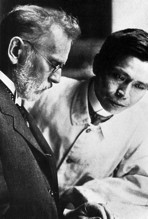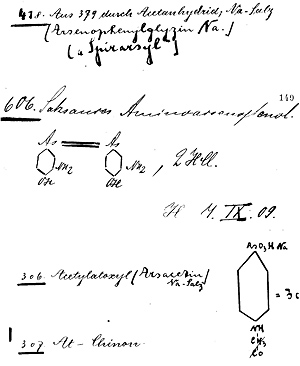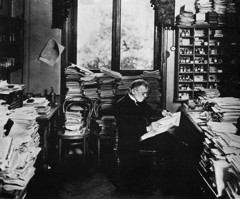Paul Ehrlich, the Rockefeller Institute, and the First Targeted Chemotherapy

Paul Ehrlich (left) and Sahachiro Hata
The German physician Paul Ehrlich (1854-1915) announced in 1910 the development of an arsenic-based drug called Salvarsan ("the arsenic that saves") that was effective against syphilis, an important threat to public health worldwide. It was the first drug methodically developed to treat a specific disease, and the crowning achievement to a career that contributed fundamentally to knowledge of immunology, hematology, chemistry, histology, and pharmacology, and had already been recognized by a Nobel Prize in 1908.
Ehrlich's interest in finding targeted drugs dated back to the 1890s when he noticed that synthetic dyes could selectively stain specific pathogens and not their host cells. He experimented first with methylene blue as a therapy for malaria. In the early 1900s he studied the effectiveness of trypan red against the trypanosomes that cause African sleeping sickness. He next turned to an arsenic compound that had been tested against trypanosomiasis, and proceeded to determine its chemical structure and synthesize more than a thousand variations of it. The spirochete that causes syphilis was discovered in 1906. Soon after, Ehrlich's student and colleague Sahachiro Hata (1873-1938), who had succeeded in infecting rabbits with syphilis, joined his laboratory, and the two scientists set about systematically screening their collection of arsenic compounds for activity against syphilis, and testing the results in animals. Compound number 606, arsphenamine, turned out to be Ehrlich's "magic bullet."

Three entries in Paul Ehrlich's laboratory notebook dated 1906-1912 illustrate the development of Salvarsan 606
During this research, Ehrlich maintained strong ties to the leaders of the new Rockefeller Institute, founded in 1901. In 1903, Christian Herter, perhaps the most influential member of the Institute's Board, spent the year working and observing in Ehrlich's laboratory, and the two became close friends. Ehrlich also corresponded regularly with Simon Flexner, the Institute's first director. That was how, in 1909, Flexner knew that Ehrlich's research was coming under increasing financial strain. Flexner went directly to John D. Rockefeller to request support for Ehrlich's work. Rockefeller responded with a gift of $10,000, which was channeled through the Rockefeller Institute as a grant to Ehrlich. Ehrlich received notice of this grant in August of 1909, a time when he and Hata were in the midst of screening their arsenic-based compounds. That fall, when compound number 606 was found to be effective, they tested it in animals for safety, and then in patients with primary syphilis. In April of 1910 they announced their results at the Congress for Internal Medicine at Wiesbaden.
Salvarsan was the most effective syphilis treatment available, and Hoechst began manufacturing the drug in 1910. But it was difficult, and sometimes risky, to administer. Ehrlich continued to refine the compound, and announced the synthesis of Neosalvarsan (neoarsphenamine), which was more soluble in water, in 1914. In the meantime, the Rockefeller Hospital was one of the first recipients of the 65,000 free samples of Salvarsan that Ehrlich distributed, free of charge, so that further clinical testing could be done. At Rockefeller, Homer F. Swift (1881-1953) developed a safe and successful method to use Salvarsan in treating the dementia and paralysis of late-stage syphilis. By 1923, 2 million doses a year of Salvarsan and Neosalvarsan were being manufactured in the United States, and these drugs remained in use until the introduction of penicillin in the 1940s.

The researcher's office, a repository for journals, books, and papers of every kind
Paul Ehrlich was educated at the universities of Breslau, Strassburg, and Freiburg, and received his medical degree from the University of Leipzig in 1878. After research at the Charité Hospital in Berlin, Ehrlich joined the faculty of the University of Berlin in 1882. In 1890 he was invited to work at the Koch Institute, where he developed methods to produce high-grade sera against diphtheria and other toxins. In 1899 the Institute for Serum Research and Serum Testing was established for Ehrlich outside Berlin. In 1906, Ehrlich became the first head of the newly established Georg-Speyer-Haus, a research institute for chemotherapy. Ehrlich was a member of some 81 international academies and learned societies, and the recipient of ten honorary degrees. In addition to the 1908 Nobel Prize, shared with Ilya Illyich Mechnikov, he received the Prussian Great Gold Medal for Science (1903), was named full honorary professor of the University of Gottingen (1904), and was appointed Privy Councillor to the government of Prussia (1911).
Selected Publications
Ehrlich P. Diskussionsbemerkungen zum Vortrag von Wechselmann (Chemotherapie der Syphilis). Bericht ueber die Tagung der Freien Vereinigung fuer Mikrobiologie, 1910, 47: 223-224
Ehrlich P. Die Behandlung der Syphilis mit dem Ehrlichschen Präparat 606. Deutsche medizinische Wochenschrift, 1910, pp. 1893-1896.
Swift HF and Ellis AWM. The treatment of syphilitic affections of the central nervous system, with especial reference to the use of intraspinous injections. Arch Intern Med, 1913, 12: 331-345
Further Reading
Bäumler E. Paul Ehrlich: Scientist for Life. Grant Edwards, trans. New York: Holmes & Meier, 1984
Bosch F and Rosich L. The Contributions of Paul Ehrlich to Pharmacology: A Tribute on the Occasion of the Centenary of His Nobel Prize. Pharmacol, 2008, 82: 171-179 http://content.karger.com/produktedb/produkte.asp?typ=fulltext&file=000149583
Chemical and Engineering News: The Top Pharmaceuticals That Changed the World: Salvarsan http://pubs.acs.org/cen/coverstory/83/8325/8325salvarsan.html
Board of Directors' Minutes, 29 May 1909 and 9 October 1909, RG 110.2, Rockefeller University Archives, Rockefeller Archive Center
Links
Nobel Foundation http://nobelprize.org/nobel_prizes/medicine/laureates/1908/ehrlich-bio.html
Paul Ehrlich Institute http://www.pei.de/cln_046/nn_162438/EN/institute-en/paul-ehrlich-en/paul-ehrlich-node-en.html?__nnn=true
